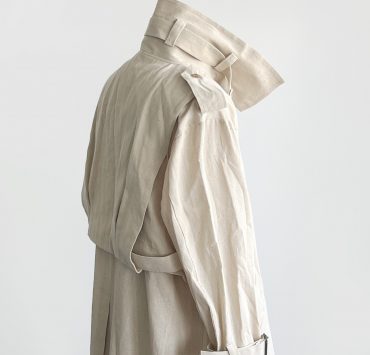This is an essay about the place and the people who had inspired the story of Amur.
To create a cohesive storyline with the garments, I decided to eschew modern Chinese metropolises. I did not want to repeat the Eastern mysticism of Noon either. The rugged garments needed to be in a place that felt like the frontier of a civilisation. For that, I looked towards Northern China.

Northern China boasts a wide expanse of uninhabited borderlands that had been drawn and redrawn due to multiple wars between tribes throughout a few Millenia. To the West lies Inner Mongolia, Shaanxi and Xinjiang. To the East are the three Northernmost provinces that makes up what was once called Manchuria during the Japanese occupation. It was here that the Qing Dynasty – the last of China’s imperial dynasty – was born, and ultimately met its demise.
Though the seat of the throne was located in Beijing, the tribe who founded the Qing Dynasty began as semi-nomadic shepherds and farmers in these Northern borderlands. They were first called the Jurchens, then renamed themselves as the Manchus upon ascending to power. Far away from the Forbidden Palace, ordinary Manchu peasants lived up North next to Siberia and Mongolia.

At the height of the Qing Dynasty’s rule, the empire – including its tributaries – spanned from Tibet, the entirety of Mongolia (both Inner and Outer), all the way to the Korean peninsula. Late 19th Century saw imperial armies from foreign lands carving up the kingdom one by one to cement their position in the coming world wars, creating territorial conflicts that still persist to this day. There is a saying that it takes three generation for a family to rise and fall; the first to build the foundation of wealth, the second to grow and prosper, the third to squander everything away. For the Qing, it took 267 years.
These days, Manchuria is simply known as Dongbei – a literal translation for Northeast. I had initially picked out Heilongjiang – China’s Northernmost province – as the backdrop of the editorial. Its name – meaning Black Dragon River – was taken from the river that snaked around its Northern periphery. In Russian, it is known as the Amur River. Heilongjiang’s older urban areas reflect the amalgamation of Russia and China. As neighbours, they have learned to live with each other like an old married couple, a relationship that waxes and wanes throughout centuries. Developed by the Russian Empire in 1898, Heilongjiang’s capital city Harbin was a small village that flourished into a major transport hub for Russia’s Chinese Eastern Railway, complete with wide boulevards and ornate Orthodox churches. At the turn of the 20th Century, over fifty nationalities lived alongside each other, cementing its international status rivalling that of Shanghai.

Beyond Harbin, Heilongjiang is a sparsely inhabited province, providing plenty of open spaces for the editorial. Alas, the weather right before Christmas plummeted to minus twenty five degree Celcius. Considering we were not shooting puffers and fleeces, I decided to look elsewhere for the sake of practicality.
As I turned my attention towards the south of the Dongbei region, I found the coastal city of Weihai that boasts surreal sceneries. Located eleven hundred kilometres south of Harbin, one would expect the weather to be milder but it was still freezing, albeit at ten degrees below zero rather than twenty-five. Dwellers in southern Chinese cities are used to crossing multiple provinces within a six hour drive. It takes twenty hours to drive from Harbin to Weihai. Only when one travels in the North one gets the feel of how large the country truly is.

Weihai, a small city of three million – small by Chinese standard – is not exactly a sought-after tourist destination, especially when compared to its neighbour Qingdao. A little known naval base that was once loaned to the British Empire, it too became the battle ground for power-wrestling in the 20th century. Having seen its fair share of death and destruction, it made a recovery and marched to the tune of progress at its own leisurely pace. Due to its coastal location and proximity to Incheon, the city is known for authentic Korean cuisine, and most importantly, the freshest affordable seafood I have ever had in the country.
It took only two hours to fly into Weihai from Shanghai, once again a reminder how far the human race has progressed, considering that such a journey would have taken many weeks just two centuries ago. Emerging out of the air bridge, I was stunned by the landscape that was awash in pure white. Snow fluttered outside the window. Visually mesmerising but worryingly cold, I had thought that we were evading a deep winter. Instead, we landed straight into a snowstorm.
We stayed in a newly-renovated hotel next to a fishing port. As we were far away from the urban center, our dining options were reduced to the local establishments. On the first night, we walked to the nearest groceries store in a snowstorm to get additional provisions, and hopefully dinner. Most of the restaurants nearby were operating, though without much patronage. In this dreadful condition no-one wants to be out and about. I couldn’t help but admire the steadfastness of the businesses to earn a living. When I asked the proprietress for a recommendation, she pointed towards an establishment a few doors down. I had seen that restaurant on the Chinese review app (大众点评) being given three and a half stars with not the greatest of reviews, but I will take granny’s recommendation over yuppy social media tourists.
The door opened to a fairly spacious eatery. Large fridges lined the left wall leading towards a semi-open kitchen, while the catch of the day was displayed in tubs. Boisterous laughter emanated from the adjacent dining room. Mirth is an excellent sign of good food, company, or liquor.
We were greeted by a tall man, whom I presumed is the owner. A lady wearing an apron was sitting with a young boy at the back having her meal, most likely the tall man’s family. As we made our way to an empty table, the other patrons gazed at us with much curiosity. In larger Chinese cities, strangers have conditioned themselves to avoid each other’s eyes, assisted with personal mobile screens. In a salt-of-the-earth town like Weihai, people’s enthusiasm for novelty has not been dampened yet. They have no fear of catching strangers’ eyes. Garbed in dark garments, we stood out like goths in a frat party. On every occupied table was a party of three to six. As their gaze lingered on us, a tiny smile broke the ice. Soon one of the red-faced uncles scooted over to ask a few questions. His curiosity satisfied, he returned to his table.




Half of the patrons were in their work uniforms, while the rest had weather-beaten faces that betrayed the nature of their professions. The room was mildly hazy from cigarettes, its smell punctuated by the occasional whiff of baijiu being poured into small glasses, to be consumed neat. With a lovely introduction of benzin, the colourless liquid goes down like jet fuel. A small dose will shoot you to high heavens. Buoyed by each others’ intoxicating presence, no-one had the time to look at their phones. It was a pleasure to be surrounded by their boisterous merriness.
Northerners are known to for their hospitality and laid-back attitude, which is ironic considering how cold the region gets. While making an order for our table, I asked the proprietress if there was ice to go with our Qingdao. She gave a small laugh before saying no, “but I’ll put it in the snow for you while we cook your order.”
Our food arrived fifteen minutes later, together with the ice cold beer. Good food in China is not hard to come by, as this country has rediscovered its culinary culture in the last few decades of prosperity. Fresh seafood however, depends on the location. Never expect fresh saltwater fish in Shaanxi province, for it would have to travel a thousand miles inland. In the port city of Weihai, freshly caught fruits of the sea cooked on the same day is a part of everyday life. From seafood noodles to stir fried clams and steamed fish, every dish I had ordered was cooked lightly in order to let the seafood’s natural juices play a major role in pleasing our taste buds. The same quality of food in Shanghai would cost triple as much, albeit served on chi-chi china. When a buck goes a longer way, it is no wonder that people seemed happier, or at least happier than the sullen, lonely faces I see in my local noodle shop. We returned twice more to the restaurant; it was that good. On the night of our departure, we bid farewell to the family after having our last dinner.
Come back next time, they said.
I think we will, I replied, before walking out the door.





